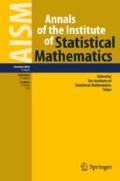Summary
The purpose of the present paper is to propose a practical procedure for the estimation of the binary response curve. The procedure is based on a model which approximates the response curve by a finely segmented piecewise constant function. To obtain a stable estimate we assume a prior distribution of the parameters of the model. The prior distribution has several parameters (hyper-parameters) which are chosen to minimize an information criterion ABIC. The procedure is applicable to data consisting of observations of a binary response variable and a single explanatory variable. The practical utility of the procedure is demonstrated by examples of applications to the dose response curve estimation, to the intensity function estimation of a point process and to the analysis of social survey data. The application of the procedure to the discriminant analysis is also briefly discussed.
Similar content being viewed by others
References
Akaike, H. (1980). Likelihood and Bayes procedure,Bayesian Statistics (eds. J. M. Bernardo, M. H. De Groot, D. U. Lindley and A. F. M. Smith), University Press, Valencia, Spain.
Akaike, H. and Ishiguro, M.. (1980). Trend estimation with missing observations,Ann. Inst. Statist. Math.,32, B, 481–488.
Cox, D. R. (1970)Analysis of Binary Data: Methuen & Co. Ltd., London
Ishiguro, M. and Akaike, H. (1981). A Bayesian approach to the trading-day adjustment of monthly data.Time Series Analysis (eds. O. D. Anderson and M. R. Perryman), North-Holland, Amsterdam.
Ishiguro, M. and Sakamoto, Y.. (1982). A Bayesian approach to probability density estimation,Research Memorandum No. 239, The Institute of Statistical Mathematics, Tokyo.
Kashiwagi, N. (1982). A Bayesian estimation procedure for fertilities in field experiments,Research Memorandum No. 220, The Institute of Statistical Mathematics, Tokyo.
Lewis, P. A. W. (1964). A branching Poisson process model for the analysis of computer failure patterns.J. R. Statist. Soc., B,26, 398–456.
Mays, C. W. and Lloyed, R. D. (1971). Bone sarcoma risk from90Sr, Biomedical Implications of Radiostrontium Exposure (eds. M. Goldman and L. K. Bustad),AEC Sympo.,25, 354.
Mays, C. W. and Lloyed R. D.. (1972). Bone sarcoma incidence vs. alpha particle dose,Radiobiology of Plutonium (eds. B. J. Stover and W. S. S. Jee), J. W. Press, Salt Lake City.
Nakamura, T. (1982). A Bayesian cohort model for standard cohort table analysis,Proc. Inst. Statist. Math.,29, 77–79 (in Japanese).
Noda, K. and Murakami, M. (1979). Estimation of two-phase segmented lines on the basis of binary data.J. Japan Statist. Soc.,12, 63–75.
Ozaki, T.. (1981). Marked point processes and non-linear systems modeling of daily rainfall and riverflow time series in stochastic hydrology,Technical Report, No. 148, Department of Mathematics, University of Manchester, Institute of Science and Technology, Manchester.
Sakamoto, Y. and Akaike, H.. (1978). Anaysis of cross-classified data by AIC,Ann. Inst. Statist. Math. 30, B, 185–197.
Sakamoto, Y. (1983). Efficient use of Akaike's Information Criterion for model selection in high dimensional contingency table analysis,Metron (to appear).
Additional information
The Institute of statistical mathematics
About this article
Cite this article
Ishiguro, M., Sakamoto, Y. A bayesian approach to binary response curve estimation. Ann Inst Stat Math 35, 115–137 (1983). https://doi.org/10.1007/BF02480969
Received:
Revised:
Published:
Issue Date:
DOI: https://doi.org/10.1007/BF02480969




